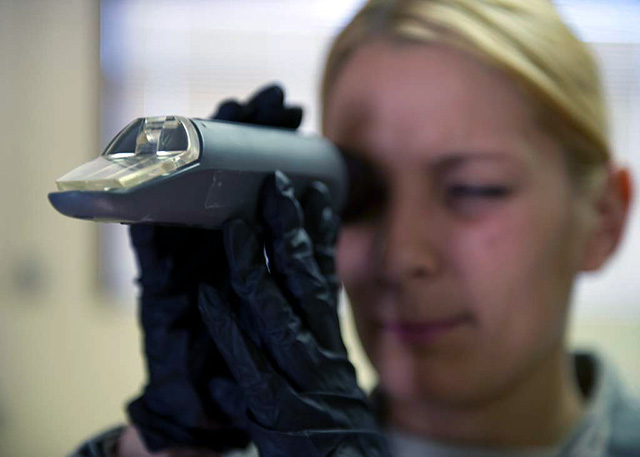Measuring urine specific gravity is a non-invasive and relatively simple method to evaluate fluid status and guide interventions to maintain optimal hydration levels. It has been shown to be the most valid and reliable method for determining moderate changes in fluid balance. A urine specific gravity measurement provides valuable information about the concentration of solutes in the urine, which is directly influenced by hydration status. Urine specific gravity reflects the ability of the kidneys to concentrate or dilute urine based on the body's fluid needs.
By regularly measuring urine specific gravity, healthcare professionals can assess changes in fluid balance, hydration status, and kidney function. It can be particularly useful in monitoring individuals with certain medical conditions, such as kidney disease, dehydration, or those undergoing specific treatments that affect fluid balance.
Method for analyzing urine specific gravity using a refractometer.
purpose: monitoring hydration levels to prevent dehydration is important for optimizing performance. Urine specific gravity is a scientific measure of hydration by measuring the density (concentration) of a urine sample.
equipment required: a refractometer (a simple hand-held version is illustrated here), urine specimen containers for urine collection, distilled water, cleaning cloth / disposable tissues, fridge or ice cooler for urine storage, gloves.
 measuring using a refractometer
measuring using a refractometerprocedure:
- Collecting the urine. The first part of the urine stream is discarded, then a small sample of urine is collected into a container. The sample can be measured immediately or stored for later measurement.
- Calibrating the refractometer. Calibrate the refractometer by placing distilled water on the glass as the sample, and adjusting the scale to read 1.000. This should be done before you begin testing, and after every ten samples or so to ensure that the calibration remains accurate.
- Measurement. Open up the flap at the end of the refractometer. Clean with distilled water and dry with a soft non-abrasive cloth. Place a drop of urine on the glass plate and close the flap. Hold the refractometer up towards an area of natural light, look through the eyepiece and read the specific gravity level off the scale - the point where the contrast line (difference between light and dark areas) crosses the scale.
results: The measurement may be done immediately after collection, or the specimen can be stored in refrigeration for later analysis. The specific gravity results will range from 1.000 (which is equivalent to water) up to 1.035 (very dehydrated). There are several criteria that are used in the literature to indicate dehydration. A simple value that is commonly stated as indicating dehydration is a value of 1.015 or greater. Usg values can also be categorized into levels of hydration as listed by Casa et al. (2000). The four levels are: well hydrated (Usg < 1.010), minimal dehydration (Usg 1.010–1.020), significant dehydration (Usg 1.021–1.030) and serious dehydration (Usg > 1.030).
comments: The sample is usually collected first thing in the morning. It may also be of interest to collect samples prior to or post-exercise, though there may be a time delay for the effect of dehydration to show in the specific gravity measure.
precautions:
- Certain medicines, vitamins or the presence of glucose may cause the urine specific gravity to change and give incorrect readings of dehydration. If any of these situations occur then the test is unreliable.
- The refractometer should be calibrated before you begin testing, and after every ten samples or so to ensure that the calibration remains accurate.
advantages: The handheld refractometer is very easy to operate.
disadvantages: This test requires the collection of urine (which is sometimes difficult) and the purchase of a specific apparatus for measurement. For a more simple test of hydration you can use urine color.
Comments: There is a minimal difference in the accuracy of the related measures of urine specific gravity, urine osmolarity, and urine color (Armstrong et al. 1998).
References:
- Armstrong, L.E., Soto, J.A., Hacker, F.T., Casa, D.J., Kavouras, S.A., Maresh, C.M. (1998). "Urinary indices during dehydration, exercise, and rehydration." Int. J. Sport Nutr. 8: 345-355.
- Casa DJ, Armstrong LE, Montain SJ, Rich BSE, Stone JA. (2000) National Athletic Trainers’ Association position statement: fluid replacement for athletes. J Athletic Training;35:212–24.
Similar Tests
- Urine color testing — assessing body hydration by looking at the color of urine.
- Sweat Collection for Analysis — collecting sweat using patches to measure electrolyte composition.
- Sweat Loss Measurement — whole body fluid loss measurement using body weight changes.
- Sweat Monitoring — skin monitors to measure sweat rate and composition.
- Sweat Rate using patches — measurement of site-specific sweating rate.
Related Pages
- Hydration for sport: a collection of articles
- About measuring dehydration
- Pre-Exercise Hydration
- Sweat Analysis Methods
- Urinalysis health testing - testing for disease and drugs


 Current Events
Current Events